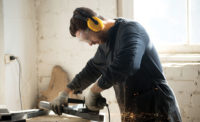
Is your hearing loss prevention program up-to-date? The following are some key points that you should review.
1 — PEL or TLV®?
This past March, the American Industrial Hygiene Association made a formal request to OSHA for the agency to update the noise permissible exposure limit or PEL (seehttp://www.aiha.org/content/accessinfo/press/spr-07-328-01.htm). The AIHA reminded OSHA that its noise standard is far out-of-date with how other nations manage this risk. U.S. OSHA is only one of two nations in the world that still use the 90 dBA PEL and one of only three nations that use the 5 dB exchange rate. Modern nations such as EU, Japan, China, etc., use the more protective and scientifically valid 85 dBA exposure limit (e.g., the ACGIH®’s TLV®) and 3 dB exchange rate; as does NIOSH, ACGIH®, and the U.S. Department of Defense (Army, Air Force and Navy).2 — Are your noise dosimeter settings correct?
If you update to the TLV® then you need to make sure that all noise dosimeters are taken off the OSHA PEL settings and adjusted to measure noise on slow response, 80 dB threshold, and 3 dB exchange rate. The dosimeter manufacturer or product distributor can provide specific instructions on how these settings are made for the instrument you use. If you contract out noise measurements, obtain assurances that the meters are set to measure as a TLV®, not PEL. Be aware that measurements using TLV® settings may find additional employees who reach the 85 dBA time-weighted average (TWA). You should also be aware that modern dosimeters may be set to measure noise differently from the TLV® or PEL objectives, such as using a 4 dB exchange rate that may have some value in some workplaces and work studies.
Table 1
3 — Exchange rates
Table 1 may help management visualize the effect of the 5 dB and 3 dB exchange rates on allowable noise exposure. The table can be expanded. Whenever the allowed hours (or comparable minutes and seconds) are cut in half, add 5 dBA to the PEL and add 3 dBA to the TLV®. For example, the TLV® only allows 0.88 seconds at a noise level of 130 dBA.We can see from the table that the difference between the PEL and TLV® exchange rates and allowable time becomes greater as the noise level intensifies.
4 — Audiometer
In addition to making sure instruments properly measure noise, you should also make sure that the audiometer used for testing employees’ hearing provides accurate and repeatable results. Because of subtle differences among machine models/types, NIOSH’s Preventing Occupational Hearing Loss: A Practical Guide recommends that the same type of instrument (and preferably the same instrument) be used from year to year.
Table 2
5 — Sample size
How many employees do you measure to determine who should be included in a hearing conservation program or wear hearing protection? Management may object to you involving more employees than necessary to reach conclusions. Since most supervisors now understand statistics to assure proper quality control, you should use this rationale to explain the number of employees who need to participate in noise measurements. You may use the following statistical example (Table 2). The sample size ensures a 95 percent level of probability that the sample will contain at least one employee in the top 20 percent of the similarly exposed group. “Similarly exposed group” is defined by grouping employees who have similar work activities and noise exposure confirmed by measurements from a sound level meter.6 — Political constraints
Are there political constraints in your company’s hearing conservation program? The Noise and Hearing Conservation Manual, Fourth Edition (Berger et al, AIHA Press) says that, “playing the political game effectively is extremely important in achieving significant progress in the hearing conservation area.” Political game means swaying people to support your beliefs.Politics may come into play when determining the major focus of a hearing conservation program. Does your worksite merely comply with OSHA or does management seek to abide by best practices? Many worksites take the politically correct stand that they will meet minimum compliance with standards and employ best practices where practical. Be careful of this play because it’s deceiving. In practice this stand usually means, “if the fix is easy, we’ll do it, if not we won’t.”
A policy signed by senior management stating the worksite will meet the TLV® for hearing protection can help overcome this problem. Management may be swayed to conforming to the TLV® when they review AIHA’s arguments (see above) to OSHA to support an updated PEL.
7 — Hearing protectors
A Noise Reduction Rating (NRR) is required on all packages of hearing protectors (plugs, muffs, etc.). The NRR, however, was devised in the lab and does not reflect workplace conditions. To meet OSHA compliance, the NRR must be recalculated (de-rated) using various formulas as provided in the noise standard. One compliance method, using the dBA, is to subtract 7 from the NRR; but even this de-rating may not be protective.OSHA advises the NRR de-rating formula of NRR –7 and then divide the result by 2. A package label of NRR of 21 then becomes 7. NIOSH provides the following recommendations: Earmuffs — subtract 25 percent from the manufacturer’s labeled NRR; formable earplugs — subtract 50 percent from the NRR; and all other earplugs — subtract 70 percent from the NRR. You should be aware that when using earplugs under earmuffs the de-rated NRRs cannot be simply added together. The earplug may only provide an additional protection of 2-3 decibels. This issue should be thoroughly discussed with your safety equipment supplier.
It’s not enough to simply instruct employees on how to properly use hearing protectors, and a simple look at whether hearing protection is being worn does not confirm that the device is being properly used. The employee must be constantly aware if his or her hearing protector is working at its performance, and has not wiggled loose from the ear canal for example. Call it a political game if you wish, but you may have to use various incentives to sway employees to follow your beliefs why constant proper use of hearing protection is important. Finally, keeping your hearing loss prevention program up-to-date means that a periodic (e.g., annual) formal review of the program is necessary.



